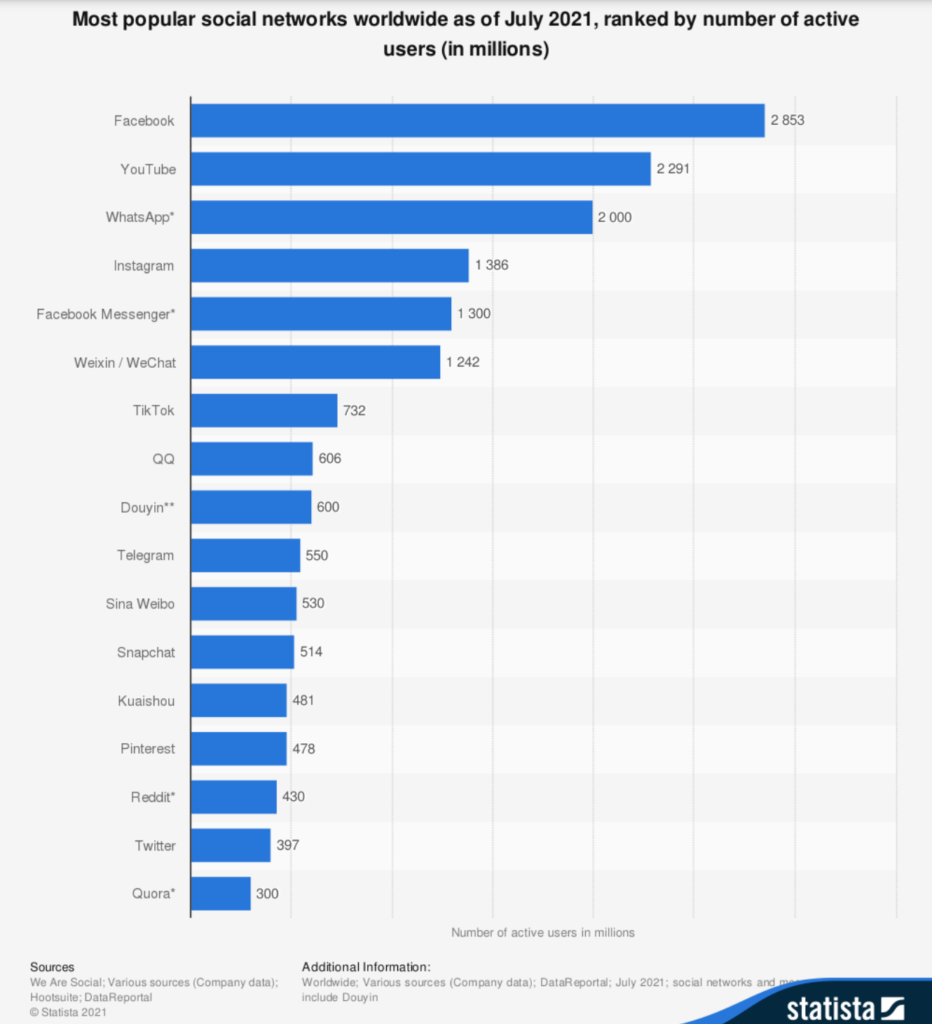Working in a digital marketing agency is very much like spinning plates. Different clients, conflicting priorities, changing trends and landscapes . . . . it feels as though there is never enough time to do anything properly.
So it is no surprise that our social media marketing strategy can get a little stale without us really noticing. And it’s time to change all that.
In this article, we will look at:
- Setting relevant social media marketing goals and measures.
- Choosing the best platforms for your brand.
- Four key social media content trends for 2022.
Setting relevant goals and measures
This may seem very obvious. But it’s all too easy to get into the routine of regularly updating social media whilst losing sight of why you are doing it and whether it is having any positive impact.
Social media marketing goals
So take time to review your social media marketing goals, and decide which to stop, start and continue.

|
Some examples of goals that you may want to include are:
- Increase brand awareness: use social media to get your name, personality and values out there;
- Grow your audience: get involved in conversations and introduce your brand to newcomers;
- Increase traffic: use interaction, promotional posts and social ads to drive traffic to your site
- Generate leads: tell the world about new products and services, and special offers;
- Process sales: do you need to start or increase the use of social media as a shopping platform?;
- Increase engagement: experiment with messaging and content to boost interaction.
- Influencer marketing: this is expected to grow rapidly in 2022, including the proliferation of influencers as brand ambassadors. You can read more about influencer marketing in our previous article The rise and rise of influencer marketing.
Measuring the effectiveness of your marketing
Whichever combination of goals you set, you need to ensure that your social media marketing is data-driven and that you understand what is and isn’t producing good ROI at any given time.
Some key metrics that you may want to consider are:
- Impressions: the number of times your content is displayed, even if it was not clicked;
- Reach : the number of individual users who have viewed your post;
- Clicks : the number of clicks on your content;
- Likes : focus not just on standard likes but also organic and paid likes;
- Other reactions : also take notice of other ways in which users react to your content;
- Engagement : the ratio of social interactions to impressions;
- Hashtag performance : which hashtags were most associated with your brand?
The best platforms for your brand
The chart below – courtesy of Statista – shows the most popular social networks worldwide in July 2021.

But when choosing the right platforms for your social media marketing strategy, you need to bear in mind not just the numbers of active users, but the different audiences attracted by the different platforms.
For example,
- Facebook and YouTube both tend to attract higher-earning users;
- Facebook not only has the largest number of users, but is also viewed as the most important B2C channel for 68% of marketers and the most important B2B channel for 48% of marketers;
- YouTube is the second most popular social media channel and also the second largest search engine after Google.
- Instagram and YouTube are the most popular social networks among Millennials and Gen Z. In particular, Instagram is one of the most important social networks for marketers.
- Pinterest is more popular with women than with men, and currently has the highest average order value for social shoppers.
- LinkedIn has a professional user base so is a good platform for more in-depth, niche content.
So do your research and decide which platforms are the ones where your core audience is already active. Focus your social media marketing strategy on these rather than diluting your effort trying to cover too many channels.
Once you have decided on the most appropriate platforms, you need to make sure that your content is up to scratch and on-trend.
Key social media content trends for 2022
Below we look briefly at four key trends. We will return to each of these in separate articles in due course.
Stories and time-sensitive posts
Stories continue to grow in popularity. We covered the concept of ephemeral content a little while ago in our article How to create a buzz with ephemeral content, and since then it’s proved that it isn’t going anywhere.
Stories tap into people’s FOMO – Fear Of Missing Out. They usually appear at the top of your followers’ feeds so attract attention and stick in your audience’s minds.
Short-form video
Already over half of marketers claim video is the most valuable type of content for social media. And a key feature of video is to keep it short.
Recent research from Denmark suggests that global attention spans are reducing simply because of the amount of information that is continually being presented to the public. People have more things to focus on so will tend to spend less time on each.
It is therefore not surprising that short-form video is exploding in popularity and boosts engagement.
Relatively new platforms and technologies such as TikTok and Instagram Reels are both evidence of this.
User-generated content (UGC)
User-generated content includes images, videos, text, and audio that has been posted by users on social media. Interestingly it is a way in which consumers have in a sense taken control of the engagement process. By harnessing the power of social media to share and search for information and views, seek to resolve problems, and find out more about the brand in general.
Rather than resist this trend, if your brand can promote user-generated content – for example by asking questions and encouraging hashtags – you could increase engagement and brand loyalty.
Use augmented, virtual and immersive reality
Augmented, virtual and immersive reality are transforming the potential of social media.
- Augmented reality (AR) adds to your real-world experience.
- Virtual reality (VR) completely takes over your senses and experience.
- Immersive reality (IR) combines the two and blends digital and physical experiences.
As part of your social media marketing strategy it’s time to explore using one or more of the above technologies.
For example:
- Virtual try-on tools for clothing, cosmetics and accessories;
- Preview tools for room design, paint colours, furniture layout etc;
- 360-degree adverts that help users to experience the brand;
- Live-streamed events to engage users in real time.
These technologies enable you to extend your social media capabilities beyond where they are currently at. And, with the recent rebranding of Facebook’s parent company as Meta, you should also be aware of the growing impetus around the metaverse.
The metaverse

The metaverse is being viewed by many experts as the future of the internet. The metaverse could best be described as social human interaction via a virtual world, and probably using a virtual avatar. The metaverse will connect a variety of digital environments, and could be used for work, entertainment, live events and general socialising.
It is very telling that Facebook is heavily involved in the development of the metaverse. It recently renamed its parent company Meta, claiming the name – which means “beyond” – would better encompass what it does, particularly in terms of broadening its reach beyond social media into Augmented, virtual and immersive reality.
Facebook is in the process of recruiting 10,000 people in the European Union to work on the metaverse, but has also recently invested $50 million in funding non-profit groups to help build the metaverse responsibly.
Meanwhile, Facebook is testing the water with Horizon Workrooms, its new VR meeting space, which uses a virtual avatar system.
The metaverse may take years to develop, but the opportunities are already here to use augmented, virtual and immersive reality in social media marketing strategy, and public interest is high. So it makes sense to start incorporating some of these features sooner rather than later.
In this article we have looked at:
- Setting relevant social media marketing goals and measures.
- Choosing the best platforms for your brand.
- Four key social media content trends for 2022.
We hope that the information has been useful, and helps you to update your social media marketing strategy ready for 2022.
For more tips on how to keep your digital marketing agency at the top of its game, do visit us again soon here at Xcite Digital.
